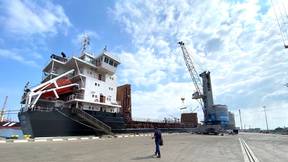From Canines to Liquefied Natural Gas
For the past several years, maritime security has been on everyone's mind. From the halls of Congress to the longshoremen working the midnight shift, the threat of a possible terrorist attack on the maritime interests of the United States and dealing with new security requirements have kept this topic on the front burner. While most in the maritime industry are relatively aware of the legislation that has been promulgated since the terrorist attacks of September 11, 2001, new evolving legislation continues to be implemented. In this regard, the most recent legislation that addresses the continuing implementation of the maritime security regime is the Coast Guard Authorization Act of 2008, HR 2830 (the "Bill").
Port Security Assessment Best Practices Examples
The U.S. Coast Guard released Port Security Assessment Best Practices Examples for consideration and possible use by the maritime industry. Generic examples addressed in the document include LNG vessels and facilities, industrial parks, bridges, pilots, and small passenger vessels. Source: HK Law
MTSA: Another Key Layer of Port Security
The Layered Defense. This classic military strategy has been used as a primary approach for defending a valuable target, infrastructure or piece of property for centuries. Medieval rulers had wide moats and drawbridges surrounding their castles, followed by high walls and armies ready with flaming arrows or large caldrons of hot metal ready to dump on the attacking force to slow their advances. Modern day security barriers are now a fixture at every U.S. embassy around the world. The idea of a layered defense has been a primary tactic that have served military commanders well. The layered defense strategy is also a cornerstone of security in the maritime arena, especially in the United States following the cowardly attack on the USS COLE.
Column: When Security is Made Simple
How are we to implement an effective Maritime Security Program? When terrorists hijacked aircraft and used them as weapons, a significant paradigm shift occurred in how we view security in the U.S. The Department of Homeland Security (DHS) was created and we were witnesses to the largest shift in federal government roles and responsibilities since World War II. Additionally, significant changes were made to the airline and maritime industries with the implementation of the Maritime Transportation Security Act of 2002 (MTSA) and its aviation counterpart. This article will discuss methodologies to assist maritime owners/operators in complying with the often confusing myriad of federal and international laws and regulations. According to the U.S.
Column: MTSA: Another Key Layer of Port Security
The Layered Defense. This classic military strategy has been used as a primary approach for defending a valuable target, infrastructure or piece of property for centuries. Medieval rulers had wide moats and drawbridges surrounding their castles, followed by high walls and armies ready with flaming arrows or large caldrons of hot metal ready to dump on the attacking force to slow their advances. Modern day security barriers are now a fixture at every U.S. embassy around the world. The idea of a layered defense has been a primary tactic that have served military commanders well. The layered defense strategy is also a cornerstone of security in the maritime arena, especially in the United States following the cowardly attack on the USS COLE.
Feature: Secure Seas, Open Ports
As new international and domestic regulations regarding shipping security enter force, the focus is not simply on security, but also on maintaining a healthy flow of commerce to keep the U.S. and world economy humming. U.S. Homeland Security Secretary Tom Ridge recently announced the implementation of new security measures designed to build upon the layers of security that are already in place at the nation's ports. The new measures, required by the Maritime Transportation Security Act, add additional security protections to every port in the United States. Port and vessel protection continues to remain one of the Department of Homeland Security's highest priorities.
USCG Admiral Testifies on Chem Facility Security
WASHINGTON - Coast Guard Director of Port Security, Rear Adm. Craig E. Bone, testified today on chemical facility security before the Senate Homeland Security and Governmental Affairs Committee. “Considering the vast economic utility of our ports, waterways and coastal approaches, it is clear that a terrorist incident against a facility in our marine transportation system could have a disastrous impact on public safety, the environment, our nation’s economy, and international trade. Such an incident, if it were to occur in a strategic port, could also threaten our military mobilization capabilities. An incident at one of the 350 chemical…
Coast Guard Admiral Testifies on Chemical Facility Security
Coast Guard Director of Port Security, Rear Adm. Craig E. Bone, testified today on chemical facility security before the Senate Homeland Security and Governmental Affairs Committee. His written statement submitted for the record, follows. "Good morning Madam Chairperson and distinguished members of the Committee. It is a pleasure to be here today to discuss the U.S. Coast Guard’s role in securing the chemical facilities on the navigational waterways of the United States. The men and women of the U.S. Coast Guard and the Department of Homeland Security remain committed to improving maritime homeland security each and every day through continued interagency cooperation and assistance from our partners at the local, state and international levels, as well as maritime industry stakeholders.
TSAC Plans Fall Meeting
DC. Thursday, September 12, from 9:00 a.m. to 3:30 p.m. to discuss working group progress on ongoing TSAC projects. The formal meeting will take place on Friday, September 13, from 8:00 a.m. to 1:00 p.m. on the Port Security Assessment Program. All meetings are open to the public. room for Thursday's session is TBD. TSAC will meet in Room 2415, U.S. headquarters, 2100 Second Street, SW, Washington, DC.
USCG: Protecting the American People
Commemoration of the Sept. We pause at this time to recognize the sacrifice of the victims of the Sept. 11th attacks. Our deepest sympathy goes out to their families, loved ones, and to the survivors. We appreciate the public’s support, understanding and assistance as the Coast Guard works to keep the nation’s ports and waterways safe and secure. We have made changes, refocused our efforts, and developed new tools and policies, but we already had many of the skills, authorities, systems and response plans and brave, dedicated men and women to immediately raise the level of security to protect the American people. As America’s premier multi-mission, military, maritime agency, Homeland Security and Search and Rescue are, and have been, our top priorities.








